Yancheng He
Asymmetric Proximal Policy Optimization: mini-critics boost LLM reasoning
Oct 02, 2025Abstract:Most recent RL for LLMs (RL4LLM) methods avoid explicit critics, replacing them with average advantage baselines. This shift is largely pragmatic: conventional value functions are computationally expensive to train at LLM scale and often fail under sparse rewards and long reasoning horizons. We revisit this bottleneck from an architectural perspective and introduce Asymmetric Proximal Policy Optimization (AsyPPO), a simple and scalable framework that restores the critics role while remaining efficient in large-model settings. AsyPPO employs a set of lightweight mini-critics, each trained on disjoint prompt shards. This design encourages diversity while preserving calibration, reducing value-estimation bias. Beyond robust estimation, AsyPPO leverages inter-critic uncertainty to refine the policy update: (i) masking advantages in states where critics agree and gradients add little learning signal, and (ii) filtering high-divergence states from entropy regularization, suppressing spurious exploration. After training on open-source data with only 5,000 samples, AsyPPO consistently improves learning stability and performance across multiple benchmarks over strong baselines, such as GRPO, achieving performance gains of more than six percent on Qwen3-4b-Base and about three percent on Qwen3-8b-Base and Qwen3-14b-Base over classic PPO, without additional tricks. These results highlight the importance of architectural innovations for scalable, efficient algorithms.
Part I: Tricks or Traps? A Deep Dive into RL for LLM Reasoning
Aug 11, 2025Abstract:Reinforcement learning for LLM reasoning has rapidly emerged as a prominent research area, marked by a significant surge in related studies on both algorithmic innovations and practical applications. Despite this progress, several critical challenges remain, including the absence of standardized guidelines for employing RL techniques and a fragmented understanding of their underlying mechanisms. Additionally, inconsistent experimental settings, variations in training data, and differences in model initialization have led to conflicting conclusions, obscuring the key characteristics of these techniques and creating confusion among practitioners when selecting appropriate techniques. This paper systematically reviews widely adopted RL techniques through rigorous reproductions and isolated evaluations within a unified open-source framework. We analyze the internal mechanisms, applicable scenarios, and core principles of each technique through fine-grained experiments, including datasets of varying difficulty, model sizes, and architectures. Based on these insights, we present clear guidelines for selecting RL techniques tailored to specific setups, and provide a reliable roadmap for practitioners navigating the RL for the LLM domain. Finally, we reveal that a minimalist combination of two techniques can unlock the learning capability of critic-free policies using vanilla PPO loss. The results demonstrate that our simple combination consistently improves performance, surpassing strategies like GRPO and DAPO.
IC-Custom: Diverse Image Customization via In-Context Learning
Jul 02, 2025Abstract:Image customization, a crucial technique for industrial media production, aims to generate content that is consistent with reference images. However, current approaches conventionally separate image customization into position-aware and position-free customization paradigms and lack a universal framework for diverse customization, limiting their applications across various scenarios. To overcome these limitations, we propose IC-Custom, a unified framework that seamlessly integrates position-aware and position-free image customization through in-context learning. IC-Custom concatenates reference images with target images to a polyptych, leveraging DiT's multi-modal attention mechanism for fine-grained token-level interactions. We introduce the In-context Multi-Modal Attention (ICMA) mechanism with learnable task-oriented register tokens and boundary-aware positional embeddings to enable the model to correctly handle different task types and distinguish various inputs in polyptych configurations. To bridge the data gap, we carefully curated a high-quality dataset of 12k identity-consistent samples with 8k from real-world sources and 4k from high-quality synthetic data, avoiding the overly glossy and over-saturated synthetic appearance. IC-Custom supports various industrial applications, including try-on, accessory placement, furniture arrangement, and creative IP customization. Extensive evaluations on our proposed ProductBench and the publicly available DreamBench demonstrate that IC-Custom significantly outperforms community workflows, closed-source models, and state-of-the-art open-source approaches. IC-Custom achieves approximately 73% higher human preference across identity consistency, harmonicity, and text alignment metrics, while training only 0.4% of the original model parameters. Project page: https://liyaowei-stu.github.io/project/IC_Custom
Reinforcement Learning Optimization for Large-Scale Learning: An Efficient and User-Friendly Scaling Library
Jun 06, 2025Abstract:We introduce ROLL, an efficient, scalable, and user-friendly library designed for Reinforcement Learning Optimization for Large-scale Learning. ROLL caters to three primary user groups: tech pioneers aiming for cost-effective, fault-tolerant large-scale training, developers requiring flexible control over training workflows, and researchers seeking agile experimentation. ROLL is built upon several key modules to serve these user groups effectively. First, a single-controller architecture combined with an abstraction of the parallel worker simplifies the development of the training pipeline. Second, the parallel strategy and data transfer modules enable efficient and scalable training. Third, the rollout scheduler offers fine-grained management of each sample's lifecycle during the rollout stage. Fourth, the environment worker and reward worker support rapid and flexible experimentation with agentic RL algorithms and reward designs. Finally, AutoDeviceMapping allows users to assign resources to different models flexibly across various stages.
KORGym: A Dynamic Game Platform for LLM Reasoning Evaluation
May 21, 2025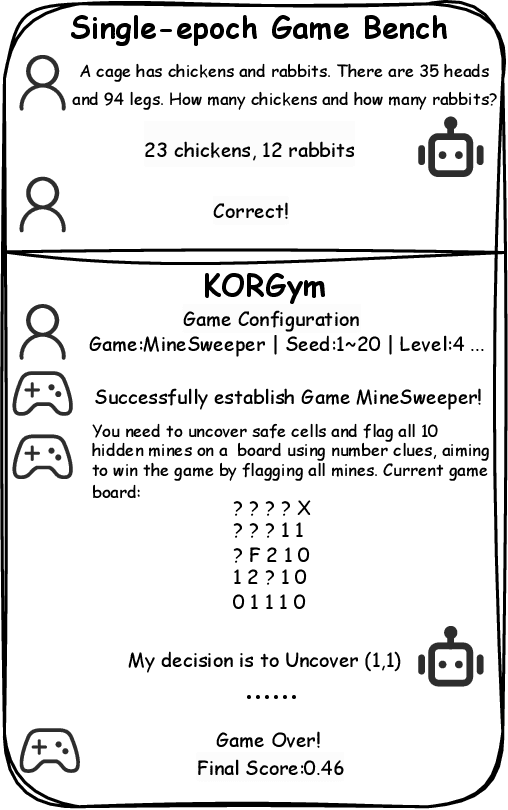
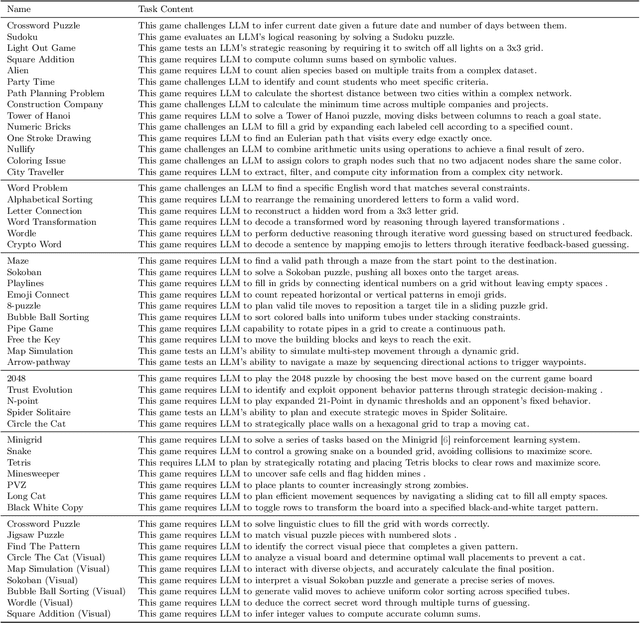
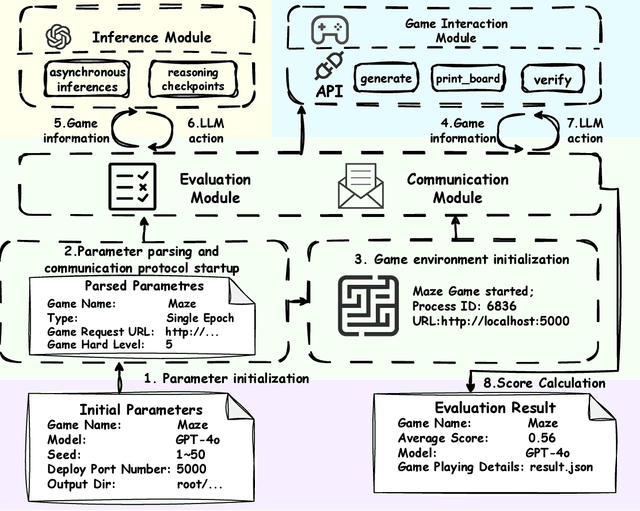

Abstract:Recent advancements in large language models (LLMs) underscore the need for more comprehensive evaluation methods to accurately assess their reasoning capabilities. Existing benchmarks are often domain-specific and thus cannot fully capture an LLM's general reasoning potential. To address this limitation, we introduce the Knowledge Orthogonal Reasoning Gymnasium (KORGym), a dynamic evaluation platform inspired by KOR-Bench and Gymnasium. KORGym offers over fifty games in either textual or visual formats and supports interactive, multi-turn assessments with reinforcement learning scenarios. Using KORGym, we conduct extensive experiments on 19 LLMs and 8 VLMs, revealing consistent reasoning patterns within model families and demonstrating the superior performance of closed-source models. Further analysis examines the effects of modality, reasoning strategies, reinforcement learning techniques, and response length on model performance. We expect KORGym to become a valuable resource for advancing LLM reasoning research and developing evaluation methodologies suited to complex, interactive environments.
Think-J: Learning to Think for Generative LLM-as-a-Judge
May 20, 2025Abstract:LLM-as-a-Judge refers to the automatic modeling of preferences for responses generated by Large Language Models (LLMs), which is of significant importance for both LLM evaluation and reward modeling. Although generative LLMs have made substantial progress in various tasks, their performance as LLM-Judge still falls short of expectations. In this work, we propose Think-J, which improves generative LLM-as-a-Judge by learning how to think. We first utilized a small amount of curated data to develop the model with initial judgment thinking capabilities. Subsequently, we optimize the judgment thinking traces based on reinforcement learning (RL). We propose two methods for judgment thinking optimization, based on offline and online RL, respectively. The offline RL requires training a critic model to construct positive and negative examples for learning. The online method defines rule-based reward as feedback for optimization. Experimental results showed that our approach can significantly enhance the evaluation capability of generative LLM-Judge, surpassing both generative and classifier-based LLM-Judge without requiring extra human annotations.
DREAM: Disentangling Risks to Enhance Safety Alignment in Multimodal Large Language Models
Apr 25, 2025Abstract:Multimodal Large Language Models (MLLMs) pose unique safety challenges due to their integration of visual and textual data, thereby introducing new dimensions of potential attacks and complex risk combinations. In this paper, we begin with a detailed analysis aimed at disentangling risks through step-by-step reasoning within multimodal inputs. We find that systematic multimodal risk disentanglement substantially enhances the risk awareness of MLLMs. Via leveraging the strong discriminative abilities of multimodal risk disentanglement, we further introduce \textbf{DREAM} (\textit{\textbf{D}isentangling \textbf{R}isks to \textbf{E}nhance Safety \textbf{A}lignment in \textbf{M}LLMs}), a novel approach that enhances safety alignment in MLLMs through supervised fine-tuning and iterative Reinforcement Learning from AI Feedback (RLAIF). Experimental results show that DREAM significantly boosts safety during both inference and training phases without compromising performance on normal tasks (namely oversafety), achieving a 16.17\% improvement in the SIUO safe\&effective score compared to GPT-4V. The data and code are available at https://github.com/Kizna1ver/DREAM.
IV-Bench: A Benchmark for Image-Grounded Video Perception and Reasoning in Multimodal LLMs
Apr 21, 2025Abstract:Existing evaluation frameworks for Multimodal Large Language Models (MLLMs) primarily focus on image reasoning or general video understanding tasks, largely overlooking the significant role of image context in video comprehension. To bridge this gap, we propose IV-Bench, the first comprehensive benchmark for evaluating Image-Grounded Video Perception and Reasoning. IV-Bench consists of 967 videos paired with 2,585 meticulously annotated image-text queries across 13 tasks (7 perception and 6 reasoning tasks) and 5 representative categories. Extensive evaluations of state-of-the-art open-source (e.g., InternVL2.5, Qwen2.5-VL) and closed-source (e.g., GPT-4o, Gemini2-Flash and Gemini2-Pro) MLLMs demonstrate that current models substantially underperform in image-grounded video Perception and Reasoning, merely achieving at most 28.9% accuracy. Further analysis reveals key factors influencing model performance on IV-Bench, including inference pattern, frame number, and resolution. Additionally, through a simple data synthesis approach, we demonstratethe challenges of IV- Bench extend beyond merely aligning the data format in the training proecss. These findings collectively provide valuable insights for future research. Our codes and data are released in https://github.com/multimodal-art-projection/IV-Bench.
ChineseEcomQA: A Scalable E-commerce Concept Evaluation Benchmark for Large Language Models
Feb 27, 2025
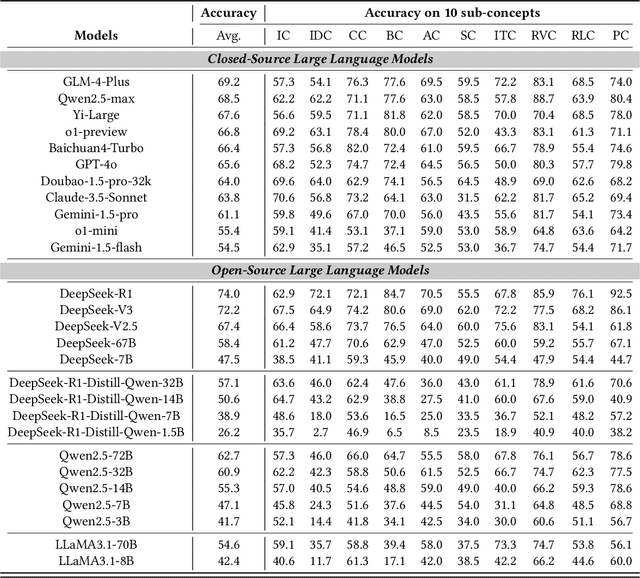
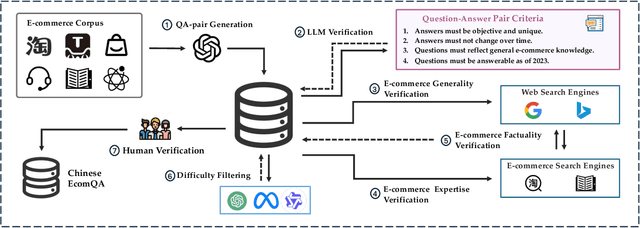

Abstract:With the increasing use of Large Language Models (LLMs) in fields such as e-commerce, domain-specific concept evaluation benchmarks are crucial for assessing their domain capabilities. Existing LLMs may generate factually incorrect information within the complex e-commerce applications. Therefore, it is necessary to build an e-commerce concept benchmark. Existing benchmarks encounter two primary challenges: (1) handle the heterogeneous and diverse nature of tasks, (2) distinguish between generality and specificity within the e-commerce field. To address these problems, we propose \textbf{ChineseEcomQA}, a scalable question-answering benchmark focused on fundamental e-commerce concepts. ChineseEcomQA is built on three core characteristics: \textbf{Focus on Fundamental Concept}, \textbf{E-commerce Generality} and \textbf{E-commerce Expertise}. Fundamental concepts are designed to be applicable across a diverse array of e-commerce tasks, thus addressing the challenge of heterogeneity and diversity. Additionally, by carefully balancing generality and specificity, ChineseEcomQA effectively differentiates between broad e-commerce concepts, allowing for precise validation of domain capabilities. We achieve this through a scalable benchmark construction process that combines LLM validation, Retrieval-Augmented Generation (RAG) validation, and rigorous manual annotation. Based on ChineseEcomQA, we conduct extensive evaluations on mainstream LLMs and provide some valuable insights. We hope that ChineseEcomQA could guide future domain-specific evaluations, and facilitate broader LLM adoption in e-commerce applications.
Can Large Language Models Detect Errors in Long Chain-of-Thought Reasoning?
Feb 26, 2025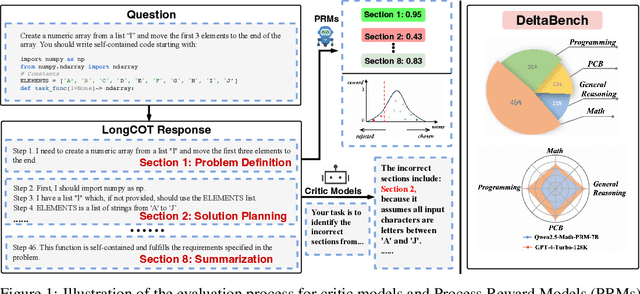
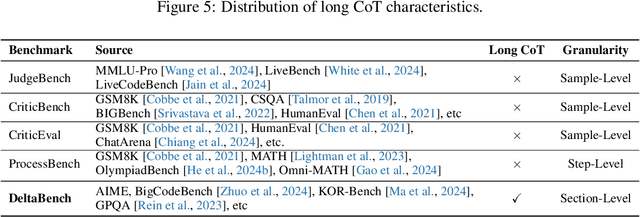
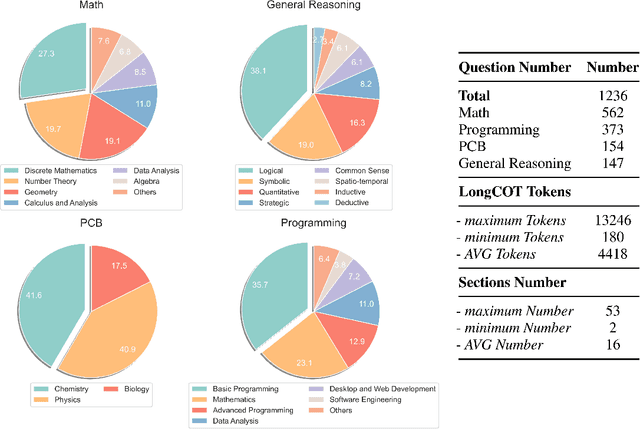
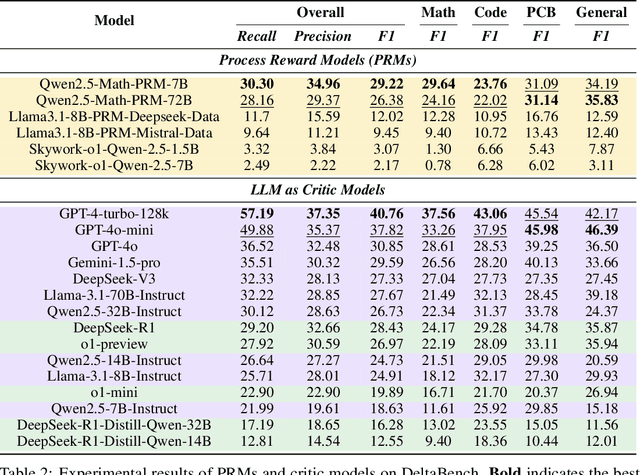
Abstract:Recently, o1-like models have drawn significant attention, where these models produce the long Chain-of-Thought (CoT) reasoning steps to improve the reasoning abilities of existing Large Language Models (LLMs). In this paper, to understand the qualities of these long CoTs and measure the critique abilities of existing LLMs on these long CoTs, we introduce the DeltaBench, including the generated long CoTs from different o1-like models (e.g., QwQ, DeepSeek-R1) for different reasoning tasks (e.g., Math, Code, General Reasoning), to measure the ability to detect errors in long CoT reasoning. Based on DeltaBench, we first perform fine-grained analysis of the generated long CoTs to discover the effectiveness and efficiency of different o1-like models. Then, we conduct extensive evaluations of existing process reward models (PRMs) and critic models to detect the errors of each annotated process, which aims to investigate the boundaries and limitations of existing PRMs and critic models. Finally, we hope that DeltaBench could guide developers to better understand the long CoT reasoning abilities of their models.
 Add to Chrome
Add to Chrome Add to Firefox
Add to Firefox Add to Edge
Add to Edge